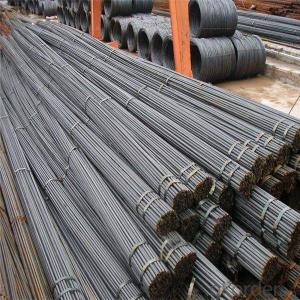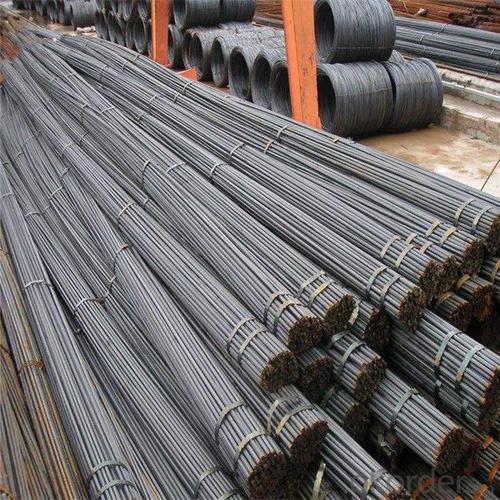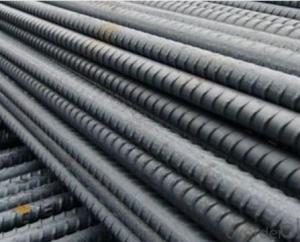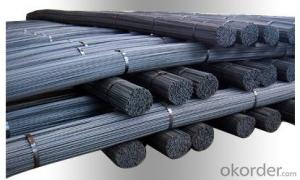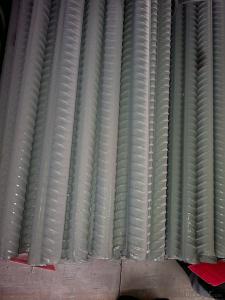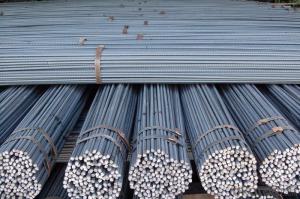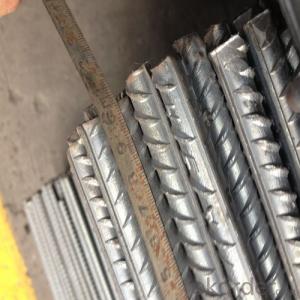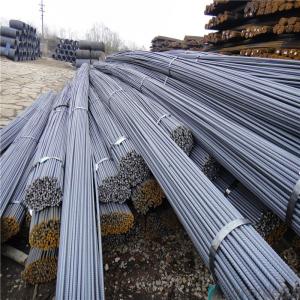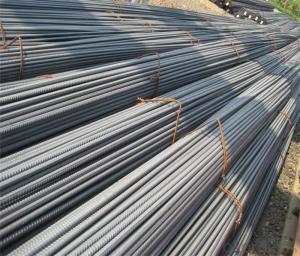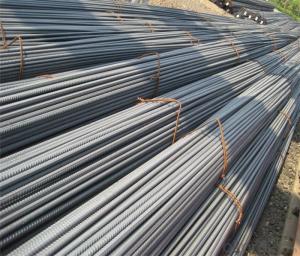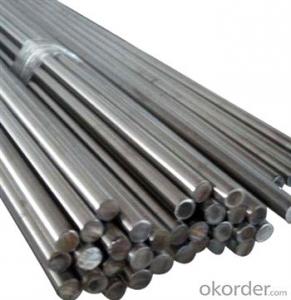GB HRB400 HRB500 BS4449 ASTM A615 GR40 GR60 steel rebar
- Loading Port:
- China main port
- Payment Terms:
- TT OR LC
- Min Order Qty:
- 1000 m.t.
- Supply Capability:
- 19863 m.t./month
OKorder Service Pledge
OKorder Financial Service
You Might Also Like
Specification
Rebar called reinforcing bars, steel rebar is metal bars often used in construction for pouring concrete or
supporting walls and columns. The rebar can be smooth, though they are frequently manufactured with
deformations that create greater texture to which concrete can adhere, creating a stronger bond that helps
prevent cracking of concrete. These deformations do not create weaknesses in the rebar, and when rebar
is measured to determine its diameter, it is typically measured at the narrowest point. Strength grades
indicate the amount of pressure the steel rebar can withstand, and grade and diameter are typically presented
in both imperial and metric units
Our Advantage:
High quality steel products from 1 class mills in China
Reasonable price
Professionalism of the products
On-time delivery
Complete documents and certificates
Sincere service to meet our clients' requirements
Product Description :
Chemical composition (%): | Steel | C | Si | Mn | P | S | Ceq | ||||
HRB335 |
0.25 |
0.80 |
1.60 |
0.045 |
0.045 | 0.52 | |||||
HRB400 | 0.54 | ||||||||||
HRB500 | 0.55 | ||||||||||
Mechanical properties | Steel | Rel/ MPa | Rm/ MPa | A/ % | Agt/ % | ||||||
≥ | |||||||||||
HRB335 | 335 | 455 | 17 |
7.5 | |||||||
HRB400 | 400 | 540 | 16 | ||||||||
HRB500 | 500 | 630 | 15 | ||||||||
Package: | Standard export packing or as customer's request | ||||||||||
Application: | Construction, building, bridge, road. ect | ||||||||||
Payment terms | 1).100% irrevocable L/C at sight. | ||||||||||
Delivery time | 15-30 days after receipt of L/C or deposit by T/T | ||||||||||
Features
1、Pure steel quality, stable chemical contents, small tolerance.
2、Constant Quality, good drawing performance.
3、High dimension accuracy degree, accuracy degree of Level C up to 80%, smooth surface, less scale, easy to be pickled.
4、Automatic bundling with 4 lines by Machine in tidy and good looks
5、Big high quality percentage, small coil percentage, and heavy coil weight for Hard Coil.
6、High sorbitizing percentage.
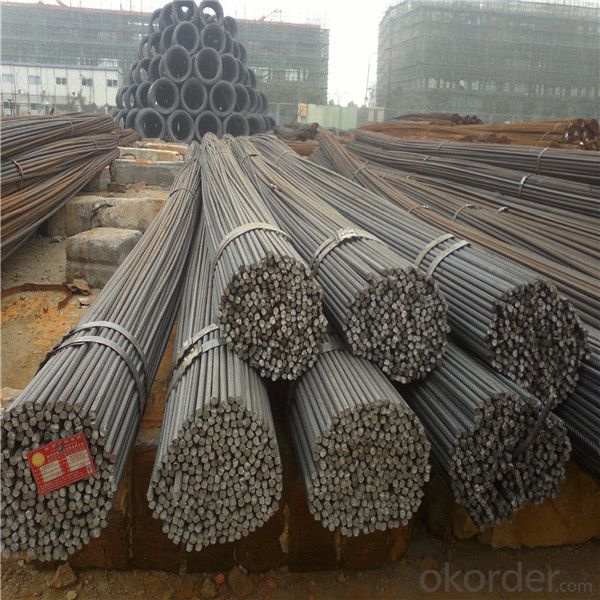
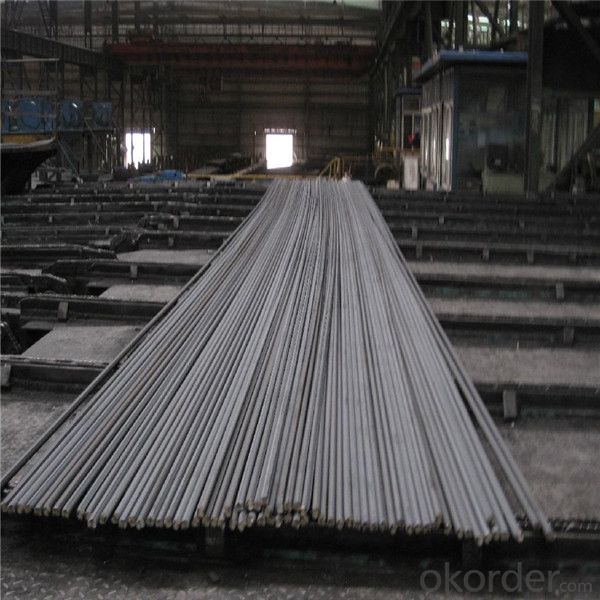
Packing:
In bundles, each bundle weight 3.5 tons. Load by container or by bulk verssel.
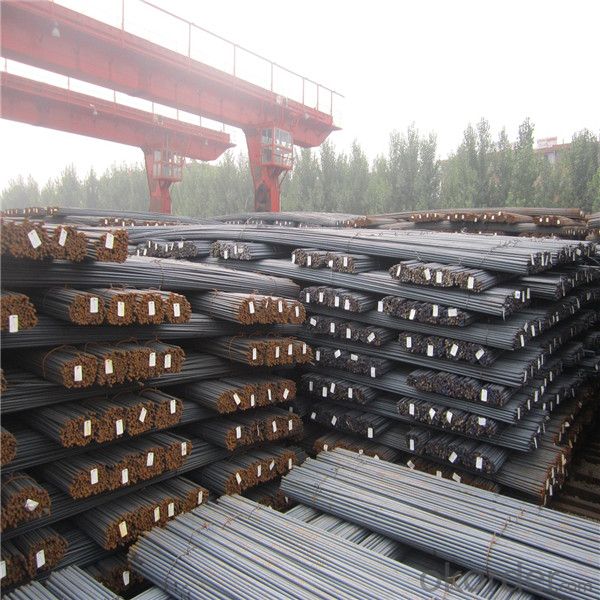
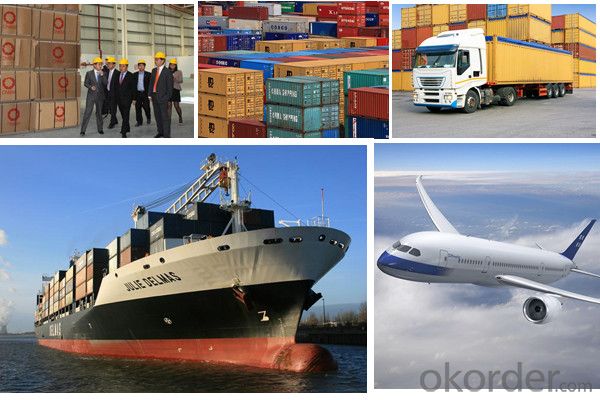
Our service
(1) We cooperate with famous factories with advanced equipment and well trained workers.
(2) We can provide factory price with trading company service.
(3) We continuously work on the improvement of our processes, guaranteeing consistently high standards
of quality to keep none compensation.
(4) We guarantee 24 hours response and 48 hours solution providing service.
(5) We accept small order quantity before formal cooperation.
(6) We deliver the agreed quality at the agreed time, reacting to changes in customer wishes in a flexible way.
(7) Due to our volume and selling power, we have excellent freight rates with shipping lines.
(8) We strive to always be fair and honest in our dealings with customers.
(9) We strive to work together with customers to achieve much more than we can achieve alone.
(10) Through our passion and commitment we aim to be a market leader in all our key markets. To maintain
our position as market leader we must continue to add value in all that we do.
FAQ:
1.Q: What's your MOQ(minimum order quantity)?
A: One full container, mixed acceptable .
2. Q: What's your packing methods?
A: Packed in bundle or bulk ..
3. Q: How can I buy CNBM products in my country?
A:Please send us an inquiry or email ,we will reply to you if there is distributor in your country
4. Q: Can we visit your factory?
A: Warmly welcome. Once we have your schedule, we will arrange the professional sales team to follow up your case.
5. Q: How long does it take to get the product if i place an order?
A:With the process of your requirements,we will pack and deliver in 3-7 days. If it is by sea shipment,it will take 15-45 days depending on different locations
- Q: Are there any limitations or restrictions on using steel rebars in construction?
- Steel rebars in construction have certain limitations and restrictions. Here are some of them: 1. Corrosion: Moisture and certain chemical environments can cause steel rebars to corrode, weakening them over time and compromising the structural integrity of the construction. To address this limitation, protective coatings or stainless steel rebars can be employed. 2. Fire Resistance: When exposed to high temperatures during a fire, steel rebars can lose strength and become malleable, leading to potential structural failure. Fireproof coatings or concrete encasement can enhance the fire resistance of steel rebars. 3. Weight: Large-scale construction projects may face challenges in transportation, handling, and installation due to the significant weight of steel rebars. Additional labor or equipment may be necessary, increasing project costs. 4. Thermal Expansion: Steel's high coefficient of thermal expansion causes it to expand and contract significantly with temperature changes. This can result in thermal stresses and concrete cracking around the rebars. Proper design techniques and the use of expansion joints can mitigate this limitation. 5. Electromagnetic Interference: Steel rebars can interfere with electromagnetic signals used in communication systems or sensitive electronic equipment, which is crucial to consider when constructing buildings with specific requirements, such as hospitals or laboratories. 6. Cost: The cost of steel rebars can fluctuate based on market conditions, availability, and quality, impacting the overall budget of construction projects, especially when large quantities are needed. It is important to acknowledge that despite these limitations, steel rebars are widely used in construction due to their strength, durability, and availability. Proper design, construction techniques, and maintenance can help overcome these limitations, ensuring the safe and efficient use of steel rebars in buildings and infrastructure.
- Q: What is the lifespan of steel rebars in marine structures?
- The durability of steel rebars in marine structures can vary due to several factors, including the quality of the steel, the environmental conditions they are exposed to, and the maintenance strategies employed. However, marine structures that are designed, constructed, and maintained appropriately can typically endure for 50 to 100 years. Typically, steel rebars used in marine structures are coated with corrosion-resistant materials, like epoxy or zinc, to shield them from the harsh marine environment. These coatings serve as an extra layer of protection, extending the lifespan of the rebars. Nevertheless, it is crucial to acknowledge that the marine environment is highly corrosive due to the presence of saltwater, humidity, and other corrosive agents. Over time, these elements can cause the deterioration of the protective coatings, exposing the rebars to corrosion. Without adequate maintenance measures, such as regular inspections, cleaning, and reapplication of protective coatings, the rebars may experience accelerated corrosion, leading to a shortened lifespan. Furthermore, the design and construction of marine structures play a critical role in determining the lifespan of steel rebars. It is essential to carefully consider factors like structural design, material selection, and detailing to minimize the risk of corrosion and ensure the longevity of the rebars. To summarize, the lifespan of steel rebars in marine structures can vary from 50 to 100 years based on factors such as steel quality, environmental conditions, and maintenance practices. Proper design, construction, and maintenance are crucial for maximizing the lifespan of steel rebars in marine structures.
- Q: How do steel rebars affect the overall stability of a structure?
- Steel rebars, or reinforcing bars, play a crucial role in enhancing the overall stability of a structure. They are primarily used to reinforce concrete structures and increase their strength and durability. The inclusion of steel rebars significantly improves the structural integrity of a building or any other construction. One of the key ways steel rebars affect the overall stability of a structure is by strengthening the concrete against tensile forces. While concrete is excellent at withstanding compressive forces, it is relatively weak in resisting tension. Steel rebars, with their high tensile strength, help counteract this weakness by absorbing and distributing tensile forces throughout the structure. This prevents the concrete from cracking or collapsing under excessive tensile loads, thereby enhancing the stability. Moreover, steel rebars also improve the structural stability by enhancing the flexural strength of a structure. Flexural strength refers to a structure's ability to withstand bending or flexing without deforming or failing. By adding steel rebars to reinforced concrete beams, columns, or slabs, the overall flexural strength of the structure increases significantly. This helps prevent excessive deflection and ensures the structure can bear the loads it is subjected to, such as the weight of the building, live loads, or external forces. Additionally, steel rebars contribute to the stability of a structure by resisting shear forces. Shear forces occur when two parts of a structure slide or move in opposite directions. These forces can cause structural failure if not adequately addressed. Steel rebars, when properly placed and anchored, restrain the concrete from shearing, thus preventing potential collapse or instability. Furthermore, steel rebars also improve the stability of a structure by enhancing resistance to seismic forces. In earthquake-prone areas, the inclusion of steel rebars provides the necessary ductility and energy dissipation capacity to withstand seismic activity. The rebars act as a network of interconnected elements, distributing the seismic forces and ensuring the structure remains stable during an earthquake. In conclusion, steel rebars greatly influence the overall stability of a structure by reinforcing concrete against tensile forces, enhancing flexural strength, resisting shear forces, and improving resistance to seismic activity. Their inclusion significantly increases the strength, durability, and integrity of a construction, ensuring it can withstand various loads, forces, and potential hazards, thereby enhancing the overall stability of the structure.
- Q: How are steel rebars checked for proper alignment during construction?
- Steel rebars are checked for proper alignment during construction using various methods. One common approach is to visually inspect the rebars to ensure they are positioned correctly according to the construction plans and specifications. Additionally, laser alignment tools or string lines may be used to ensure the rebars are placed in a straight line and at the correct depth. Construction professionals may also use measuring devices, such as calipers or tape measures, to verify the rebars' spacing and alignment. Regular quality control checks and inspections are crucial to ensure the rebars are aligned correctly, as this is essential for the structural integrity of the construction project.
- Q: How do steel rebars provide strength to concrete structures?
- Steel rebars provide strength to concrete structures by acting as reinforcement. When embedded within the concrete, rebars enhance its tensile strength, which is otherwise low. As concrete is strong in compression but weak in tension, the rebars resist the tensile forces that can cause cracking or failure in the structure. By distributing and absorbing these tensile forces, steel rebars increase the overall strength, durability, and structural integrity of the concrete.
- Q: How are steel rebars classified based on grades?
- Steel rebars are classified based on grades according to their yield strength and tensile strength. The grades range from 40 to 60, with higher numbers indicating higher strength.
- Q: How do steel rebars resist seismic forces?
- Steel rebars resist seismic forces by providing reinforcement to concrete structures. When an earthquake occurs, the rebars help to distribute the seismic forces throughout the structure, allowing it to withstand the shaking and movement caused by the earthquake. The strength and flexibility of steel rebars make them capable of absorbing and dissipating the energy generated during seismic events, preventing structural failures and enhancing the overall stability of the building.
- Q: How can the quality of steel rebars be tested?
- The quality of steel rebars can be tested through various methods to ensure their strength and reliability. Some common techniques include: 1. Visual Inspection: This involves examining the rebars for any visible defects such as surface cracks, unevenness, or corrosion that could affect their performance. 2. Chemical Composition Analysis: The composition of the steel rebars can be determined through spectroscopy or other similar methods to ensure they meet the required standards. This analysis verifies the presence and percentage of various elements such as carbon, manganese, and silicon. 3. Tensile Strength Testing: A sample of the steel rebar is subjected to tension until it fractures. The maximum force applied to the bar before breaking determines its tensile strength. This test helps identify any weak spots or inconsistencies within the rebar. 4. Bend Test: This test evaluates the ductility of the rebars by bending them to a specific angle without any signs of cracking or fracture. It ensures the rebar can withstand bending and shaping during construction without compromising its structural integrity. 5. Ultrasonic Testing: Ultrasonic waves are used to detect internal flaws or defects within the rebars. This non-destructive testing method helps identify any hidden cracks, voids, or inclusions that may weaken the rebar. 6. Hardness Test: The hardness of the steel rebars can be determined using the Rockwell or Brinell hardness test. This test measures the resistance of the rebar's surface to indentation, providing an indication of its strength. 7. Corrosion Resistance Test: The rebars can undergo corrosion testing, such as salt spray testing or electrochemical methods, to assess their resistance against rust and other forms of corrosion. By utilizing a combination of these testing methods, manufacturers, construction companies, and engineers can ensure that steel rebars meet the required quality standards and can withstand the intended load and environmental conditions.
- Q: What is the purpose of using stirrups with steel rebars?
- The purpose of using stirrups with steel rebars is to provide lateral support and prevent the rebars from buckling or sliding when subjected to tensile or compressive forces. Stirrups help enhance the structural integrity and overall strength of reinforced concrete structures, ensuring they can withstand various loads and stresses.
- Q: How do steel rebars contribute to the overall sustainability of the construction industry?
- Steel rebars contribute to the overall sustainability of the construction industry in several ways. Firstly, steel rebars are made from recycled materials, reducing the demand for new resources and minimizing the environmental impact of steel production. Additionally, steel rebars are highly durable and have a long lifespan, ensuring the longevity and stability of structures, reducing the need for frequent repairs or replacements. Moreover, the use of steel rebars in reinforced concrete allows for the construction of taller and more complex structures, maximizing the efficient use of land and reducing the need for additional construction projects. Overall, steel rebars play a crucial role in improving the sustainability of the construction industry by promoting resource conservation, durability, and efficient construction practices.
Send your message to us
GB HRB400 HRB500 BS4449 ASTM A615 GR40 GR60 steel rebar
- Loading Port:
- China main port
- Payment Terms:
- TT OR LC
- Min Order Qty:
- 1000 m.t.
- Supply Capability:
- 19863 m.t./month
OKorder Service Pledge
OKorder Financial Service
Similar products
Hot products
Hot Searches
Related keywords
